#cetacean welfare
Note
Please share all you can about Toa the orca calf, I think his story is very important. I don’t know too much but it seems like a case of activists being but in charge rather than actual experts.
Yeah it was a mess from start to finish. Toa was found stranded on the rocks, with witnesses saying the waves had thrown him up there. Already he would have been distressed and had been on his side on a hard surface for a few hours at least.
They got him back in the water and then videos of these interactions started to surface:
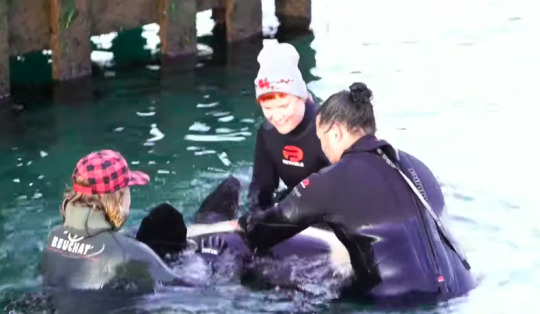
No PPE, giving Toa belly rubs and ignoring any formal rescue protocols (if you're trying to refloat a whale, you're not letting them turn upside down)
The sun was going down and DOC wanted people out of the water. Ingrid was on her way and giving instructions to her team. The decision was made to put Toa on a trailer overnight - it's unclear if that was her decision or not but it's clear that, despite not having any rehab facilities in New Zealand, people were determined to rehab this calf and release it back into the wild at any cost.
So they cobbled together a "sea pen" on a boat ramp in a dirty harbour. This is where Toa would eventually die in a few weeks time. Whale Rescue was already selling the story of a miraculous rescue and the plan to "reunite" Toa with his pod. And lying openly that orca calves had been successfully released in the wild before:
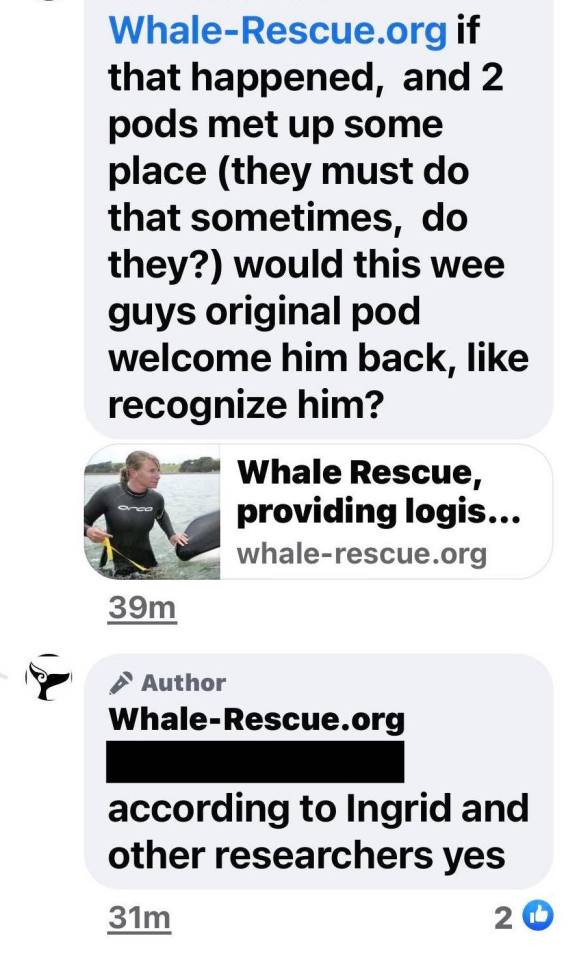
He wasn't injured, they said. He was fine. They just had to find his pod now.
When asked reasonable question about where the PPE was for volunteers, Whale Rescue immediately became defensive:
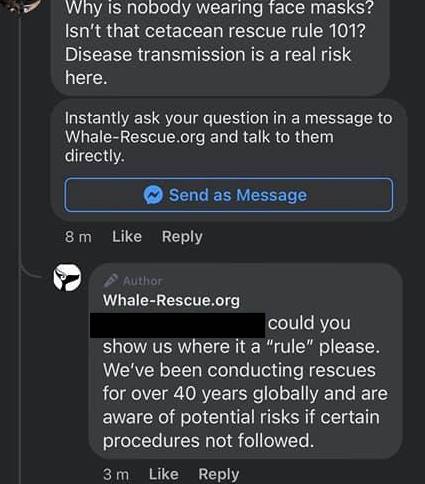
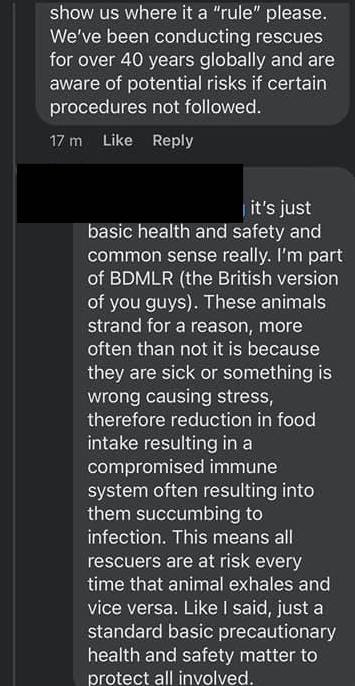
The call for PPE went ignored for about a day while people were in close contact with a sick orca. And the call went out for more "volunteers" aka anyone with a wetsuit. This sparked immediate concerns from the Advisory Group.
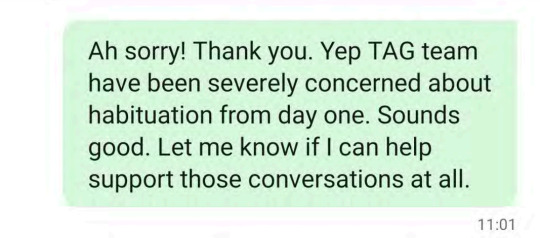

Photos like this started showing up - 6 people crowding Toa in a circle, no where for him to go if he wanted a break from people:
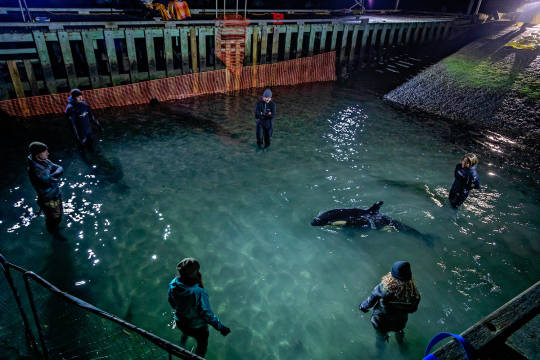
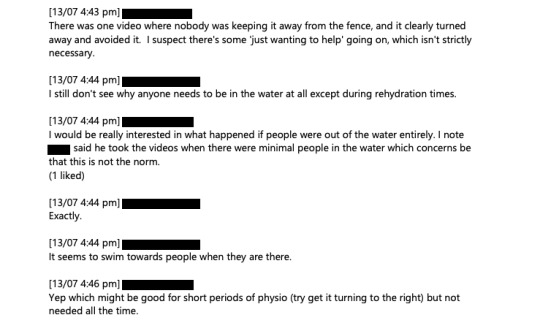
The excuse was that Toa needed help swimming. Yet he was swimming okay and avoiding the fences without any obvious issue. And so the habituation began... Despite continuing advice from the Technical Advisory Group - including Loro Parque and SeaWorld, who both have extensive calf raising experience.
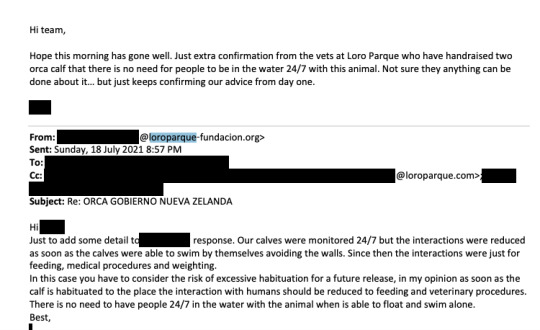
"There is no need to have people 24/7 in the water when the animal is able to float and swim alone."
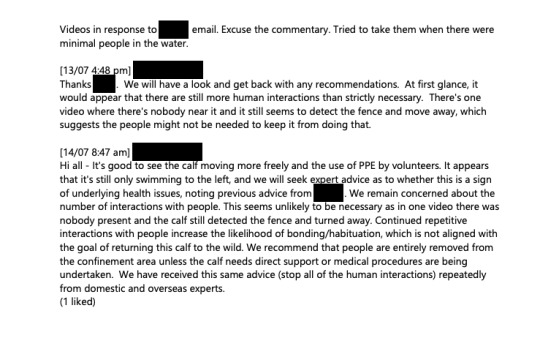
Finally PPE was being used but the habituation and intense contact with Toa continued. Ingrid gave it the okay and other inexperienced members of the public continued to encourage it.

Whale Rescue continued to affirm to the public that they are merely "duplicating natural behaviour" for Toa
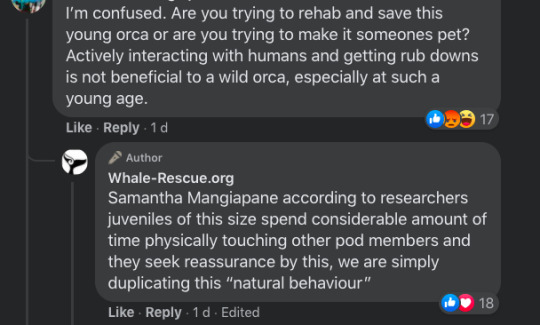

And the cultish and unquestioning worship of Ingrid Visser allowed this to continue - note the amount of people in the water for Toa's "massage." They only started wearing PPE when people started questioning it.
If you're wondering what I mean by cultish behaviour see the comment thread below:

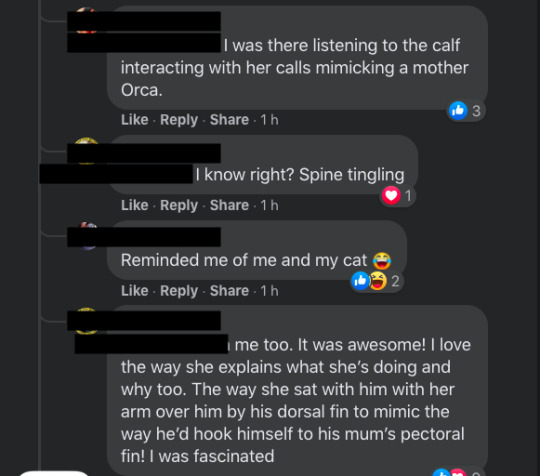
They actually believe that Ingrid was communicating with Toa. Because that's what she told them she was doing. And they believed it without question.
When Toa was moved into the freshwater pool due to storms, it got even worse.
This photo was quickly deleted but look how absolutely foul the water is:
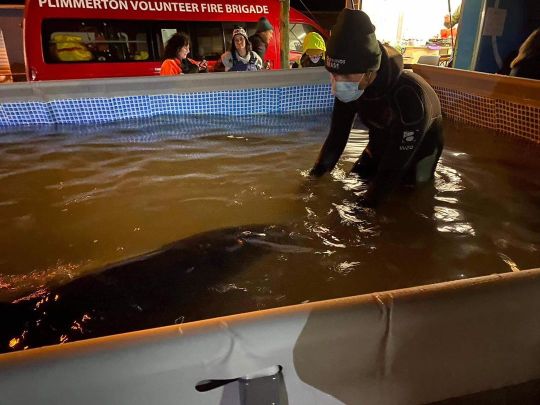
There didn't appear to be any sort of filtration or pump system.
At this point volunteers and Ingrid were being fed by donated food from the local pubs, Ingrid was sleeping on site in a donated campervan and the entire community were rallying around trying to "help." Note how close they're all set up to the pool.
Putting him in the pool also made Toa a lot more accessible. Concerns were raised about the stress to the calf and an exclusion zone was agreed upon. Buuut it was immediately disregarded.

7 people! In that tiny pool! And the photos of the complete flouting of the rules continued to surface.
The comments find it all very amusing!


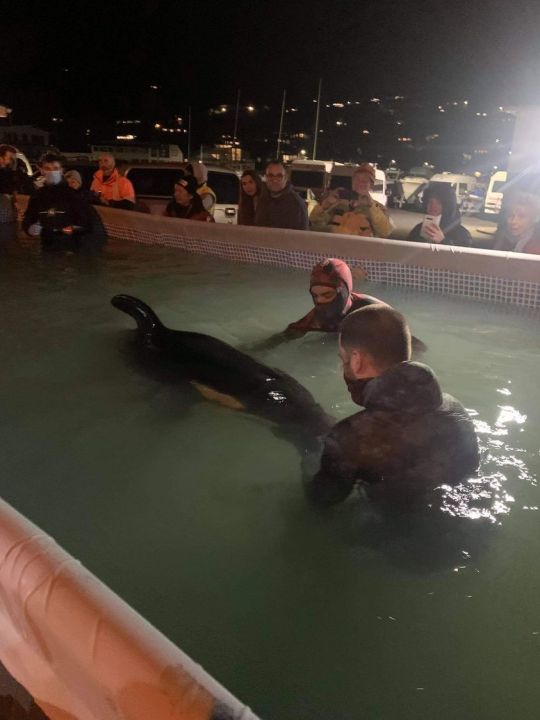
Roll up, roll up! Come and see the dying baby orca calf!
And then, as we near the end of this animal's torment, Ingrid brags to the press about how she's now TRAINING the animal she intends to release into the wild. Because we definitely want to be training cooperative care and making life saving feeding and hydrating procedures all about Choice.

Remember when Ingrid Visser didn't like the "exploitation" of orcas in captivity? Remember when she said that training "tricks", even husbandry behaviours, is cruel and bad? I do!
It makes me seriously wonder if she just wanted to be an orca trainer all her life.
But anyway, Toa's getting bouts of colic (gee, maybe changing the formula without permission wasn't a good idea!) and DOC is starting to get concerned about him. At this point, people are still denying that SeaWorld and Loro Parque are involved and any mention of a facility getting involved is immediately shut down.
This is what was being said in the Advisory Group:

At this point both SeaWorld and Loro Parque have provided formulas, advice ect. Ingrid Visser was claiming she knew these things all along and that the formulas were from her hand picked experts.
So these are what the comments were:
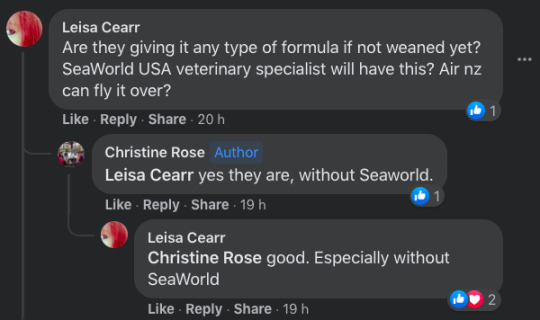
Whale Rescue thought it was appropriate to reply to comments of concern like this:

The cult of Visser continues to fuel the anti human care sentiment.
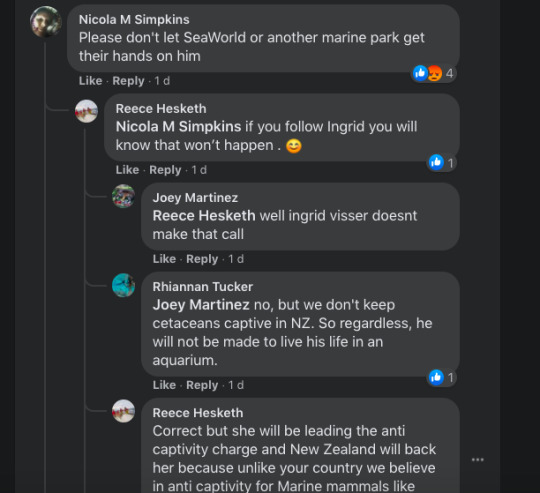
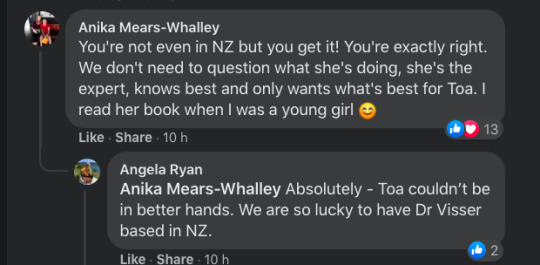
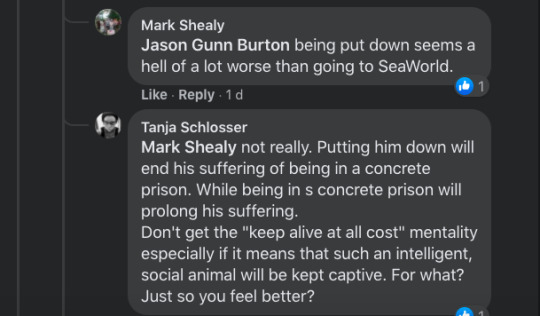
DOC starts to report concerns with Toa's health and Whale Rescue decides to double down that everything is completely Fine. Don't listen to DOC, keep giving us money.
The donations are getting up to 20k.
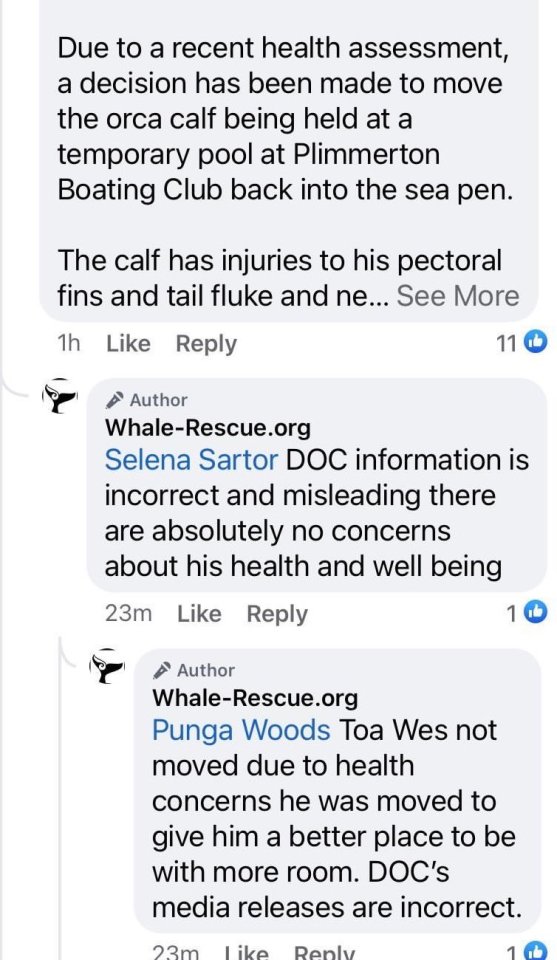

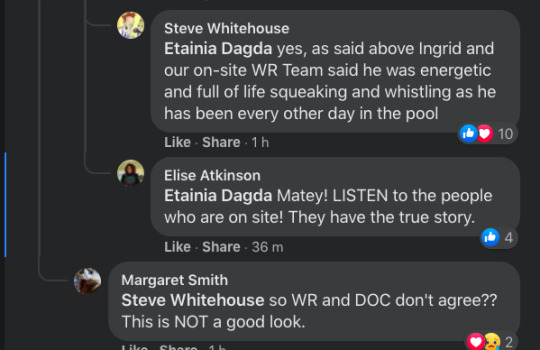
Because of Whale Rescue casting dispersions, anti DOC (Department of Conservation - who put in about 10k into the rescue efforts) sentiments grow.
And, only a few days later, Toa dies. I reached the end of my image limit but I still have plenty more screenshots I can share.
I recommend you check out the documents released by DOC to see the sources of these screenshots - the other screenshots were taken from news reports, Facebook groups and posts as well as videos:
#Toa#Toa the orca#cetacean welfare#orca#killer whale#Ingrid Visser#New Zealand#whale rescue#cetacean rehab#cetacean rescue
666 notes
·
View notes
Note
Are dolphins still being captured for aquariums/parks and is it ethical (or complicated?)
Thanks for the ask! Yes, captures unfortunately do still occur in unregulated countries, though far less frequently than in the past. One of the most infamous examples is the annual dolphin drive in Taiji, Japan. While the main purpose of this hunt is to kill animals for meat, a small number of young, attractive dolphins are kept alive each year for sale. Nowadays, only unaccredited institutions purchase these dolphins, and even the Japanese Association of Zoos and Aquariums now prohibits its members from acquiring captured dolphins. Although Taiji is the most well-known, the majority of cetaceans captured from the wild in the 2000s/2010s came from Russia, which recently prohibited the practice.
Western parks and aquariums have not purchased wild-captured cetaceans in decades. The last captures in US waters occurred in 1989, and the last foreign imports were in the early 1990s (long before widespread public sentiment turned against dolphinariums). I do not believe the practice was ethical, and almost all my colleagues would agree with me. Some of them were indeed brutal affairs, such as the infamous Penn Cove captures, in which several young Southern Resident killer whales (including the famous Tokitae) were taken. Multiple animals were inadvertently killed, and the hunters clumsily attempted to hide the deaths by stuffing the whales’ corpses with rocks. The bodies resurfaced, and following public backlash orca captures were no longer performed in the US.
As awareness of animal welfare grew amongst scientists and the general public in the 70s and 80s, collections of smaller cetacean species became considerably less vicious. They were typically supervised by a veterinarian, and care was taken to ensure animals were not physically harmed. However, these were still undeniably stressful to the animals.
I’m glad the practice stopped. Dolphins are not endangered, and I don’t think we can justify the trauma of removing healthy young animals from their pods. Of course, I make exceptions for individuals that are ill, injured, or a danger to themselves or humans (like Clearwater Marine Aquarium’s Izzy)—and these situations are never taken lightly. And if a species ever became endangered (highly unlikely for bottlenose, but a possibility for belugas), that would also be cause for reevaluation.
Dolphins do quite well in modern accredited aquariums. In the United States, all managed dolphins were either born in human care or have been out of the wild for over 30 years (excluding non-releasable rescues). While there are valid concerns about cetacean captivity, ongoing wild capture is not one of them.
#honestly I find the claim that accredited aquariums fuel taiji#to hold the same merit as claiming accredited zoos fuels the illegal pet trade#anyway thanks for reading!#this was longer than I intended#orcas#killer whales#belugas#dolphins#cetaceans#marine mammals#animal welfare#answered asks#anonymous
151 notes
·
View notes
Text
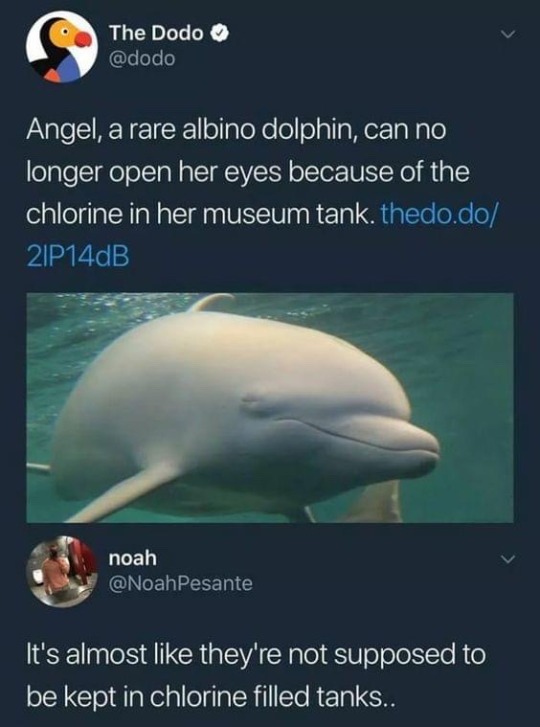
#aquariums#museums#zoos#cetaceans#mammals#dolphin#dolphins#cetacean#animal welfare#animals#nature#marine mammals
122 notes
·
View notes
Text
the simple fact that it is impossible to keep killer whales in captivity without causing the same gross anatomical deformity in over half of them should make it plainly obvious that they shouldn’t be kept in captivity at all. ALL adult male orcas, and a considerable chunk of females, whether captive-bred or wild-captured, have collapsed dorsal fins—in the wild, collapsed dorsal fins almost always occur only in orcas who are starving to death or have been injured in some way. and we don’t know if the collapsed dorsal fin has any health, social or behavior impacts! we just don’t know because captive orca facilities have stuck their head in the sand ever since they first started keeping orcas captive and refused to do any research on the phenomenon whatsoever!!! pro-captivity people will tell you in a cheerful, nothing-to-worry-about-folks tone that it doesn’t have any negative impacts, but that’s a lie, because at the end of the day, we don’t know. all we know is that something about captivity clearly causes it; we don’t even know the exact cause. in my opinion, it’s honestly ridiculous to suggest that a male killer whale’s most prominent secondary sex characteristic being totally deformed would have no bearing on his health or social status at all, but that’s just speculation too because nobody has ever looked into this phenomenon at all. that right there should prove that seaworld and their fellow captive killer whale facilities do not care about scientific research or about their animals’ welfare. if any other species experienced a gross anatomical deformity due to captivity (for example, if all male elephants’ tusks fell out, as well as some females’ tusks) and the facilities that held them refused to study it, the zoo industry would be outraged. but because it’s seaworld and they have a huge amount of money and they’re apparently the “world’s foremost experts on killer whales” (despite repeatedly ignoring the hard science from wild orca biologists that makes it obvious that their practices, such as separating moms from calves and restricting their movement, are incredibly harmful), the entire zoo industry just takes their word for it that this deformity is not harmful even though they’ve done no research on it. the dorsal fin issue makes me feel like i’m going insane; seeing smart, animal-loving people fall for this nonsense is very disheartening. it is genuinely shameful that captive killer whale facilities are so willing to overlook a blatant issue because acknowledging it would mean that—gasp!—they’d have to admit that their practices are not perfect and infallible. it would be laughable too if it wasn’t so depressing, because the welfare of these animals is being ignored. but remember kids, seaworld cares! your ticket pays for rescue and research! consume our product to save the earth!
#orcas#cetaceans#orca#killer whales#killer whale#cetacean#animal welfare#zoology#dolphin#dolphins#seaworld#cetacean captivity#orca captivity#katherine speaks
14 notes
·
View notes
Note
Regarding the anti-zoo post I have a question: wouldn't roaming be considered a form of enrichment tho?
Surviving, planning, hunting, thinking for themselves and having new experiences every day, family, herd dynamics, etc. I can't imagine an animal that is "built" to travel long distances and taking care of itself being happy with lying around all day with little to nothing to do. Prey animals might be content, but I can't imagine the same for predators.
Yeah for sure! But this is exactly why a strong enrichment programme is such a crucial part of any good husbandry plan. What kind of enrichment, and how much, depends of course on the needs of a species. But caretakers and trainers work very hard to make sure both the physical and mental needs of their animals are met.
To focus on cetaceans, this can start with the environment itself: some oceanic habitats have the influence of waves and tides, and are often filled with live fish and other naturally occurring wild animals. These provide ever-changing surroundings with lots of "entertainment" and even hunting options. But also a seemingly boring plain tank environment isn't always the same. The weather changes, birds may perch on the edge, there could be cleaning activities going on or special visits from groups/tours.
In a more barren environment the use of EED's (environmental enrichment devices) can be an important part of keeping its occupants entertained. At the Dolphin Academy in Curacao where I volunteered for a short while, the EEDs weren't very exciting and only seldom used because the dolphins could entertain themselves all day within their natural enclosures. But in other facilities, making EEDs for the animals has been turned into an artform. (See for example these contraptions!)
Training, husbandry sessions and shows are all a form of enrichment too! It allows the animal to get a physical workout, while putting their brain to work at the same time. It's also very rewarding for dolphins just for the social interaction of it: I've seen fully milk dependent calves desperate to join a session, without there being any food reward involved for them. And, not to forget: they still live in a social grouping. The interaction between their peers, social structure and hierarchy, play, fights, cooperation... this enriching aspect of social life still exists in a zoo or aquarium.
So in essence, animals under human care definitely "lose" some enriching aspects of their wild life. However, if cared for well, this void is filled up with new and different activities that keep them physically and mentally healthy. There's a whole science dedicated to making sure animals under human care lead interesting lives! Sea World Australia has a great page about all the ways they use enrichment to keep their animals happy and shows examples (plus many more) of the things mentioned above.
#I hope this answers your question a bit!#if not feel free to shoot another ask#also if anyone with more/better/actual experience working in a zoo or marine park wants to add to this - please do!#my knowledge of cetacean care and welfare is mostly theoretical and only a small bit practical#zoos#cetacean captivity#animal welfare#namtalk
15 notes
·
View notes
Text
Tell Sports San Diego That There’s Nothing Sporting About SeaWorld! | PETA
Sports San Diego (a trade name of the San Diego Bowl Game Association) still promotes SeaWorld on its Holiday Bowl website, despite knowing that the abusement park confines sensitive, intelligent orcas.
#animalrights#animal welfare#cetacean#orca#corky#seaworld#emptythetanks#activism#activist#animal rights activist#takeaction
5 notes
·
View notes
Text
Just seen a person call seaworld evil because one of the dolphins showed stereotypical behaviours (repetitive behaviours that have a variety of causes and is hard to manage/stop once it starts) and then call a video of a horse showing stereotypical behaviour (stable weaving specifically) cute and claiming the horse was dancing.
The hypocrisy is real in the anti-cap fandom
#im done with people#seaworld#stand with seaworld#pro cap#pro zoo#selective cap#cetaceans#seaworld dolphins#dolphins#horses#stereotypical behaviour#dolphin behaviour#animal behavior#animal welfare
24 notes
·
View notes
Text
I'm so sick of thoughtless "empty the tanks" discourse.
I'm against having cetaceans in captivity, but I'm sick of hearing "sea pen" and "build a bigger tank" shit. It's so fucking thoughtless and reactionary and that's why no one has come up with a better solution than "sit and wait." The vast majority of these people just wanna say a slogan and claim they love nature.
Blackfish did as much harm as it did good.
2 notes
·
View notes
Text
hardest part of being an animal welfare activist is trying to convince people that it's actually fine to eat dogs and cats and keep cetaceans in captivity
66 notes
·
View notes
Note
Please don't take this as a personal attack or anything, but how can you not hate sea world? Aren't they like very well known for abusing their animals to the point they attack and kill handlers? Usually I agree with you but like, as someone who has been to sea world... it's very much Not Good There. Genuinely wanna know how you can not have a problem with them, maybe I missed something and they've gotten better since I was a kid?
the accusations that seaworld abuses animals largely came from peta. Since the park’s inception it has been dedicated to wildlife rehabilitation and educating the public about the ocean and biodiversity. Do I agree with some of their original practices on the theme Park side? No, but that doesn’t change the fact that they are the reason we know how to captive breed sea turtles, cetaceans, and AI various marine animals. They have vastly improved the welfare of their performing animals, and some of the parks have stopped or indefinitely postponed shows involving the orcas.
The first orca attack was not caused by mistreatment of the animal (though it was in the 70s and animal welfare was not great in general), it was caused because the trainer who was asked to work with the orca while wearing a bathing suit instead of a wetsuit. The orca, Shamu, did not recognize the trainer and attacked in what she took to be an invasion of her space by an interloper.
All three of the other known orca related deaths to ever occur were caused by a single orca, Tilikum, whom you may better know as the star of Blackfish. The documentary made bold claims that Tilikum was driven insane by captivity like a human would in solitary confinement for years. These bold claims did not particularly emphasize the fact this whale was captured in the wild by a separate agency, sold to another aquarium after a year alone in a tank, left in a tank with two females which aggressively attacked him to the point he often hid in a smaller medical pool adjacent, a trainer slipped and fell into the pool with the three orcas and Tilikum grabbed her and held her under until she drowned (the two females reportedly blocked any attempts to save her), that aquarium shut down after that incident and was reported by guests to have been incredibly shabby to the point it was likely these animals were not cared for properly, that was when Tilikum was sent to seaworld. Assessments showed the animal was not behaving or reacting aggressively towards humans and the consensus was that the orca was unaware he was drowning her as he had not had many direct encounters with humans as the previous aquariums did not do shows with orcas. He was later found with the dead body of a man who had broken into the park to swim naked with the animal. First reports stated the man died of hypothermia but it was later discovered in a coroner’s report that the man was very likely held under the water and drowned as had happened to the whale’s previous victim. By then there is a pattern and the whale should have been euthanized, but the higher up staff decided it would be poor publicity to euthanize the animal and told the rest of the staff it was a freak accident unrelated to the whale.
Then we have the final incident which caused the controversial exposé documentary. I cannot emphasize enough that 3/4 human deaths caused by an orca were caused by Tilikum specifically. There is now a whale that has decided humans are fun to drag under water until they stop moving, and he does so after being excited by positive reinforcement petting which was believed to help strengthen the relationship between cetacean and trainer. He grabbed her by the hair and arm and dragged her into the pool, drowning her and slamming her against the pool floor hard enough to remove both her scalp and her arm in the process.
This death was not caused by seaworld neglecting its animals, it was caused by corporate leeches not placing any precautionary measures to prevent their staff from being harmed by the wild animals in their care. Tilikum did not attack because of anything the care staff did or did not do, he attacked because trainers were misinformed by their superiors and the attack lead to an investigation and lawsuit by OSHA.
Modern seaworld parks are much safer for the staff and care for the animals is still very important to those who work there. The shows are actually very enriching for the animals and they have long been trained with positive reinforcement, but PETA has conflated them with the unethical circus acts such as “dancing” bears and other atrocities. Because PETA does tend to do that.
On the corporate end? Yes. Seaworld has done skeevy things in the past. But as far as the people who actually care for the animals go, it’s fine. Cetacean care in captivity is still very much evolving as a science, and research towards cetacean welfare and conservation has been pioneered by seaworld whether you like it or not.
In parting, I will also add that it is a myth that all captive orcas have a floppy dorsal fin like Tilikum had. It isn’t caused by depression, it was likely a genetic mutation that is still seen in captive bred orcas from his line.

A lot of the hatred against seaworld has done more harm than good and was both misguided and misdirected from the people responsible leading to consequences for the animals and realistic goals of their conservation efforts.
656 notes
·
View notes
Text
"I first met Tokitae (also known as Toki, Lolita and Sk’aliCh’elh-tenaut), a female orca who had been captured off the coast of Washington, in 1987. I was a biology graduate student at my first professional conference, and the scientific society hosting this event held the opening reception at the Seaquarium.
Toki was 20 feet long and 7,000 pounds, and should have been in the Salish Sea traveling 40 miles a day and diving 500 feet deep with her mother and siblings. Yet there we were, a few hundred marine mammal scientists who mostly did field research, watching this magnificent being perform silly tricks in a bathtub.
That’s not really an exaggeration in Toki’s case. Toki’s tank was the smallest enclosure in the world for her species. It was only 35 feet at its widest point and 80 feet long. It was 20 feet at its deepest; if Toki hung vertically in the water, her tail flukes touched bottom. Captured in 1970 when she was 4 or 5 years old, she lived in this tiny space for 53 years.
The federal Animal Welfare Act (AWA), administered by the US Department of Agriculture, has a ludicrous requirement for tank width — only twice the length of an average adult orca (or 48 feet). But Toki’s tank didn’t even meet that weak standard. For years, the USDA offered various excuses for not taking steps to revoke the exhibitor’s license. None of them made sense, as the tank was plainly not to code. Activists repeatedly tried to sue the USDA for failing to enforce the law, without success.
Toki’s was a strange, lonely life. Despite many campaigns to repatriate her to her family (the L pod in Puget Sound), years passed. The stadium around her slowly and literally crumbled.
The ‘Blackfish’ Effect,” named after the 2013 documentary that eventually reached tens of millions of people globally, has shifted the captive cetacean paradigm in the past decade. Businesses have severed ties with marine theme parks, and policymakers have passed laws ending the commercial display of orcas and other cetacean species. SeaWorld, the company that built its brand on Shamu, is phasing out orca display — no longer capturing, breeding or trading them.
And still Toki languished in the South Florida heat. The Seaquarium’s two owners during Toki’s first 52 years there were adamant that she would never leave the park and disdainfully dismissed talk of returning her to her family.
In March 2022, however, Toki’s outlook finally seemed brighter. The Seaquarium was sold to a company whose business model relied primarily on swim-with-dolphin encounters. An orca didn’t fit that model, and these owners were willing to let her go. Efforts could finally begin in earnest to return her home. The Lummi Tribe, who gave her the name Sk’aliCh’elh-tenaut and considered her a relative, had prepared detailed plans for a seaside sanctuary in the Salish Sea.
Then, last month, Toki died. The hope felt by so many that she would finally go home disappeared in an instant.
Captivity robs orcas of a true life in the deep open sea. It robs them of family, of purpose, of change and challenge. Captivity is tremendous monotony for these socially complex, wide-ranging, intelligent animals. We should not perpetuate that.
Zoos and aquariums long ago relegated dancing bears and tricycle-riding chimps to circuses, but still claim that cetacean shows — loud extravaganzas featuring leaping orcas and cavorting dolphins — are educational (they are not). The industry could and should invest in seaside sanctuaries — it’s a win-win choice, as the industry would be heroes and the animals’ welfare would improve.
Let Toki’s miserable, isolated life and sad death mean something for her fellow captives. These amazing beings should not have to die to finally be free."
Dr. Naomi Rose is senior scientist (marine mammal biology) for the Animal Welfare Institute in Washington, D.C.
42 notes
·
View notes
Note
Hi! Given your experience working with marine mammals and intelligent views on cetacean captivity, I wanted to ponder the following. Here in the Netherlands is a cetacean (mostly porpoise) rescue organisation. After years of having no facilities, and having a 100% kill policy unless a porpoise could be returned straight away, they finally have a gorgeous rescue facility again.
Recently they announced the facility would be getting an outdoor expansion, featuring habitats emulating the Wadden Sea ecosystem. Providing both education about its inhabitants, as well as a place for late-stage rehab porpoises to spend their last weeks before release outside, in a larger habitat. And, in case an animal is non-releasable, provide an adequate space to hold them for while while next steps are being assessed.
The response was overwhelmingly negative. Most of their following is cetacean-smitten, but completely anti-cap (of the emotional, uninformed type). They all bristled at the idea that perhaps a few sharks and seals would be kept there "and then you'd be no better than a zoo!" (which is of course the worst thing to be). But mostly: the amount of people saying they would honestly rather see a non-releasable porpoise killed, because death is preferable to spending a single day in captivity ("because that is what I would want"), is frankly staggering. What do you say to these people??? A rescue facility is getting a beautiful outdoor expansion - GREAT! How can someone claim to love the animals so much when they would rather see them dead than in a situation that makes them personally uncomfortable? It just boggles my mind and frustrates me to no end.
Tl;dr: people want rescued porpoises dead because they might end up in captivity, and have you found an appropriate response to this ridiculous line of thinking?
Wow that's really amazing that the Netherlands is stepping up like that! It sounds like a great option for rehab and also to provide much needed education about porpoises to the public.
Honestly my response to those people is pretty much what you said: "Why do you want to see these animals dead just because it makes you personally unhappy to see them in human care?"
I think it's important to call out these comments as what they are: advocating for the death of animals. It's not noble, it's people projecting their own guilt complexes (of something they have no control) over onto animals.
And that is what a lot of anti captivity propaganda relies on - shame and guilt. That's what I remember when I was starting to allow myself to learn more about SeaWorld after being so convinced by Blackfish for a long time. I felt a hollow shame feeling in my chest as if being curious about how killer whales are trained was somehow wrong or bad.
Activist marketing (especially The Dolphin Project and anything from Naomi Rose, Lori Marino and Ingrid Visser) is about making you feel bad for even considering going to marine parks or learning more about cetaceans in human care. As if it would genuinely make a difference on things like Taiji or improve the lives of the animals in any way (it won't and it looks like it's only making things worse at this point)
A lot of these activists have massive egos and savior complexes that are fed by this sort of marketing. As if their snarky comment on Facebook is going to make a difference.
At the end of the day, they're people that have to make zero personal sacrifice (going to a marine park is not a hard thing to do for them) to feel a sense of moral superiority. And that's very reinforcing and feels good.
If you calmly give them the facts about cetacean welfare in human care and tell them exactly what they're advocating for (death or poor welfare)- it may not change their mind (because that's not how our brains work) but it may convince the people reading the comment thread.
161 notes
·
View notes
Note
When horses end up with severe leg/hip injuries, they are almost always put to sleep. The odds of recovering full mobility from such injuries are slim and the odds of reinjury are high, so even if the horse is perfectly healthy in all other aspects, it is generally recognized to be more humane to put them down than to keep them alive just to live the rest of their lives limping around a small paddock or stall. A life for a horse in which s/he cannot gallop, leap, explore and play is no life at all. Why not apply the same logic to cetaceans? A life for a cetacean in which they can’t dive hundreds of meters, make meaningful autonomous choices (“should I play with the rubber ball or the puzzle feeder today?” is not a meaningful choice; research has shown that autonomy is crucial for animal welfare), echolocate and experience the rich biodiversity of the ocean is no life. I really don’t understand why it’s so horrible to think it more humane to euthanize a confused and sick orca calf if there is no chance of rehab and release than to take her/him permanently into captivity. It’s not disparaging or hateful to cetacean trainers to say so—I know they care about animals—it’s simply a logical ethical stance. Instead of searching in vain for orca conservation organizations that aren’t “radically anti-captivity”, maybe pro-caps should look inwards and ask themselves why all the major orca organizations (Center for Whale Research, Orca Behavior Institute, OrcaLab, Wild Orca, Orca Conservancy, Far East Russia Orca Project, etc.) as well as some cetacean organizations (ex. Whale and Dolphin Conservation, Cetacean Society International) oppose captivity. Is it because all of these esteemed groups, which if you look them up are all staffed by credentialed scientists, have been duped by the “animal rights agenda”, or could it be because maybe, just maybe, they know what they’re talking about? If captive orcas are so different from wild ones that wild orca biologists have no credibility to speak about their welfare, then that’s a clear indictment of captivity already.
Hi. I'm sorry for not answering right away, I was still at my externship when I got your ask, and I wanted to be able to sit down and give you a proper answer. So unfortunately, I don't think what I say will satisfy you. I don't expect to change your mind, nor is that my goal here. I only want to explain why I believe the way I do, so that you or others reading this can at least understand that it's not a position I take lightly, nor do I think it's infallible.
(Long post below the cut):
To start off, as an (almost) veterinarian, there are absolutely plenty of circumstances where I find euthanasia to be the correct decision. Euthanasia is our final gift to our patients, a swift and painless death in the face of prolonged suffering or poor quality of life. A large dog with debilitating osteoarthritis. A cat with terminal lymphoma. A down cow. A raptor with an amputated leg. Or like you mentioned, a horse with a fractured hip. These animals would live in a constant state of pain that they don't understand, and death can rightly be considered a kindness to them.
But an otherwise healthy orca calf? I would consider that a false equivalence. I agree that life in the wild should be prioritized whenever possible, and that captive orcas lead very different lives than their wild counterparts. But if that orca cannot return to the wild (orphaned and unable to be reunited with its pod, habituated to humans, non-painful disability such as deafness), and there is a facility willing to take it on, I do not think euthanasia is an appropriate option. In human care, that calf can still swim, breach, and dive, even if not to the same depths as the ocean (it's also worth noting that these are all costly behavior energetically and are not performed for no reason). It can still socialize and form family bonds with an adopted pod of whales. It can still (theoretically) mate and rear calves. It can still engage its big brain in problem-solving through training and enrichment in the place of hunting. And as a bonus, it will never go hungry and has access to veterinary care if ill or injured.
This is not a wild life. This is not the same life they would've, or should've known. A pool, no matter how well-appointed, is not the ocean, and we should not claim they're comparable. But I don't think it's a fate worse than death. I truly don't. But if it is... if freedom really is worth more than life, then all captive whales need to be euthanized. Even in a sea pen setting, they will not be free. They will not choose their food, their companions, their enrichment, their comings and goings. Those choices will still be made on their behalf by caregivers, and they will still have pretty much the same levels of autonomy as in their tank habitat. They will still be captive. (While some people do advocate for this, I don't think it's a popular outlook. Even SOS Dolfijn, a historically anti-cap organization, recently announced plans to build an aqauarium as a permanent home for non-releasable cetaceans rather than continuing to euthanize them).
Speaking of autonomy, yes, it is very important. But I truly don't think the orcas are distressed by the lack of meaning in choosing between enrichment devices. I think that's why we disagree on this topic... we have different worldviews. We both see orcas as beautiful, intelligent creatures, but I do not see them as people. They are animals, and for all their complexity, I interpret their behavior the same way I do any other species... they are motivated by food, reproduction, and (since they're highly social) companionship. Because of that, I still think we can give them a good life in human care, which is why it frustrates me to see the zoo community throw up their hands and give up rather than trying to improve our current less-than-ideal setups (*shakes my fist at the Blue World project*).
Now, I don't think it's wrong to be emotional about animals. I most definitely am! And it's very clear to me you love orcas and care about their wellbeing deeply. I admire that about you, and I appreciate your passion.
On to the next point... in the cetacean world, I've found that there is an unfortunate divide between researchers and caregivers who work with cetaceans in human care and those who study them exclusively in the wild. And that schism far predates the Blackfish era. Most of those organizations you listed are indeed legitimate, and I fully support their vital work and encourage others to do the same. A few of them, though, share things like this:

I think you can understand why this hurts me. And it's a lie. I've now interned at three aquariums (two of them AZA-accredited) that house various species of cetacean, and it's impossible for me to reconcile what I know and have seen to be true and what Whale and Dolphin Conservation wants the public to believe: that these unbelievably loved, vivacious animals are drugged and tortured by their greedy captors. It's not true, and I do not appreciate WDC for spreading this creepy artwork around. Nor do I think that fighting captivity is a beneficial allocation of resources when there is an overwhelming number of genuine threats to the survival of wild cetaceans.
Anyway, back to the scientists. Personally, I don't consider researchers who work exclusively with wild orcas to be either superior or inferior to those who work with captive whales. And sometimes I wonder how much of their position is a self-fulfilling prophecy: if someone opposes captivity on moral grounds, they won't work with captive whales, so they'll never get to know what their lives and care are like beyond maybe a single tour of the park or memories of how things were done in the 1960s (like Dr. Spong, who worked with some of the very first captive orcas at the Vancouver Aquarium).
I also don't think it diminishes the expertise of wildlife biologists to say that they are not experts on husbandry, training, or medical care... those are very different fields, and ideally, they should all inform each other. And of course, there are folks who work with both wild and captive whales. One of the reasons I linked SR3 in my previous post is they have staff with backgrounds in both managed care and research of free-ranging populations (I actually have no idea what the organization's official stance on captivity is, it's not something they address).
Maybe I'm wrong. I try my best to keep an open mind, but I know I'm also swayed by my own preconceptions and experiences. When I started this blog in December 2020, I was a first year vet student with minimal actual experience outside of domestic animals and some herps, and had only recently adopted the pro-captivity outlook. Now, I'm much more deeply involved in the zoo and aquarium world. These are people I know and respect, people who have written me letters of recommendation and comment on my Facebook posts, people I've had dinner with and showed up with after hours to care for a sick animal. And I recognize that biases me. The zoo world is often resistant to change, especially folks who have been in the industry for many years. And that doesn't do anyone, especially the animals, any good. I don't want to get stuck in an echo chamber, so I make it a point to read anti-captivity literature, even when it upsets me. If there is anything I can do to improve their lives, I want to learn about it, regardless of the source.
I try to adapt to new information. For example, in the past few months alone, I've become a lot more favorable toward the idea of sea pen habitats. My concerns about "sanctuaries" are more logisitical* and philosophical** rather than the idea that artifical habitats are inherently superior to pen habitats (they're not), especially when plenty of traditional facilites already make great use of ocean pens or enclosed lagoons. There are pros and cons to both, and a lot of it depends on the needs of the individual animals.
*funding; maintenance; lack of land-based backup pools and fully-equipped medical facilities; introducing immunologically naive animals to pollutants and infectious agents; disruptions to native wildlife; staffing activists and wildlife biologists rather than those with relevant husbandry experience
**villainizing aquariums; promoting the project as a "release to freedom" to the public when it's really another form of captivity; claiming the animals' lives will be "natural" when they will still require training, artificial enrichment, contraceptives, and social management if done correctly; downplaying or completely denying the very real risks of such a transition and insisting the animals will automatically be better off when Little White and Little Grey have proved that's not the case
If you made it to the bottom, thanks for reading. I wish all the best for you, and I mean that genuinely ❤️ even if we disagree, I hope you can appreciate our shared love for these animals and a desire for their wellbeing. Best of luck in all your endeavors!
#also no hard feelings if you unfollow me#I understand#orcas#killer whales#dolphins#cetaceans#marine mammals#animal welfare#cetacean captivity#pro captivity#anti captivity#aquariums#answered asks#anonymous
147 notes
·
View notes
Photo

Blue whales, the largest animals on earth, can be found year-round off the southern tip of Sri Lanka in the Indian Ocean, resulting in a high risk of collisions as the usual international shipping lanes pass right through the area where most of the whales congregate. MSC Mediterranean Shipping Company has taken a major step to help protect blue whales and other cetaceans living and feeding in the waters off the coast of Sri Lanka by modifying navigation guidance in line with the advice of scientists and other key actors in the maritime sector.
MSC said the action was taken in response to research conducted by the International Fund for Animal Welfare (IFAW) along with other groups and universities.
The vessels passing through Sri Lanka's coastal waters will now travel about 15 nautical miles to the south from the previous route. We love blue whales! They are the largest living animals on earth and they can reach 80 to 100 feet in length and live for 70 to 80 years. Source: Business Insider (link in bio) #bluewhales #whales #conservation https://www.instagram.com/p/Ci2ZyIoLsB8/?igshid=NGJjMDIxMWI=
49 notes
·
View notes
Text
hey, it's me. i'm not coming back to tumblr permanently, but i figured i'd post this here as a virtual diary entry of sorts (and because i don't know anyone irl that wants to talk about cetaceans at the moment). maybe this post will change people's minds, or at least get them thinking. this isn't directed at anyone or anything; it's more to clear my mind and hopefully inform others about orca captivity, seaworld, etc.
the past six months have been very difficult for me. i'm doing better now, but i'm just not at the place in life i thought i would be at right now. throughout my struggles, one of my biggest sustainers has been my passion for animals, and orcas have been my predominant obsession for a while now. the felidae family, especially lions, will always have my heart—they're the first animal i fell in love with, and they will always be incredibly fascinating and awe-inspiring to me. however, orcas have seized hold of me in a way that i can't really describe. everything i've learned about them has blown me away, from their uniquely stable, mostly nonviolent and matriarchal social structure to their incredibly diverse hunting techniques to their cultural behaviors to the wide diversity of their physical appearance. i just love them so much.
as such, it is inevitable that i would encounter debates about captivity in the course of my internet travels in search of ever more information about these animals. for most of my life, i was unapologetically pro seaworld, viewing them as no different from any other zoo or aquarium and their critics as simply having been bamboozled by the film blackfish (although i staunchly refused to actually watch the film until a few months ago, only listening to how seaworld and its supporters depicted the film to me). by the time i started this blog, i had grown more critical of them, as reflected in my pinned post. at that time, i was more critical of killer whale captivity in general than of seaworld specifically. however, after i had to leave my former college in the middle of the semester due to my mental health, i found myself with a lot of time on my hands before the start of the semester at my new college, so i started doing some more research. as a history nerd, i have always been interested in the history of human interactions with wildlife, and the history of human interaction with orcas is unique from an anthrozoological perspective. i became particularly interested in the era just before and after the release of blackfish in 2013—how seaworld, the scientific community, the animal advocacy community, and the public at large responded, and the lasting reverberations of that era today. i fired up the wayback machine and began painstakingly examining any website i could find from that era that had to do with that topic, from awesomeocean.com to seaworldofhurt.com (neither of which are credible sources, btw: awesome ocean is basically a seaworld-funded buzzfeed clone and seaworld of hurt is run by peta). what i found blew me away in the worst way possible.
the website i spent the most time on was askseaworld.com/ask.seaworldcares.com (https://web.archive.org/web/20160110084856/http://ask.seaworldcares.com/). i cross-checked the information posted there with a little-known website i urge everyone to check out, https://www.seaworldfactcheck.com/ (which i didn't have to use the wayback machine to access, because seaworld has attempted to purge pretty much everything related to the blackfish era from their websites whereas anticap websites haven't). only a handful of the sheer volume of questions they received were fact-checked by seaworldfactcheck, so i had to check a lot of them myself. i was flabbergasted by the responses seaworld posted on askseaworld. they ranged from just your typical corporate pr messaging to outright lies. a common thread running through all of them was a complete refusal to admit that they ever did anything wrong in their entire history. that's something that the entire zoological field has trouble doing, but never had i seen it on such clear display. for example, they audaciously claimed that kohana's calves weren't inbred, and that the degree of relatedness between kohana and her calves' father, keto, is standard practice in ex situ breeding programs. meanwhile, the aza says that inbreeding is to be avoided here and here. additionally, these two pages, while they focus on pedigree dogs, stress that a coefficient of inbreeding (the likelihood of having identical alleles from a common ancestor on both sides of the pedigree) over 5% leads to problems, and kohana's calves had an inbreeding coefficient of 6.25%. i'm no geneticist, but sw's response to that question is questionable, to say the least. when asked about the whales they captured from the wild, they only used the word "collected", which came across to me as corporate doublespeak attempting to obfuscate the trauma and utter cruelty of ripping these complex, cultural, family-oriented animals from their families permanently for the primary purpose of entertainment—which, regardless of their current messaging, was undeniably the purpose of seaworld when it was founded (see page 9 of that link, which is also an incredibly well-researched and well-referenced argument against marine mammals in captivity that cannot be dismissed out of hand just because it comes from an anticap source). they refused to offer even a semblance of regret for how those captures were carried out—even a halfhearted "society's standards for animal welfare were different back then" or "at the time, we had no idea how this sort of thing could impact these animals" would be better than what they said, which was simply that "those were a long time ago". ok, but just because we didn't know it was wrong back then doesn't mean it wasn't wrong. it was just as wrong then as it was now, and seaworld doesn't even say it would be wrong for them to do so now; they just repeat the same line over and over about their last captures being decades ago.
however, none of these are as bad as the askseaworld response that appalled me the most. it genuinely made me question every positive thing i had ever heard about seaworld. unlike most of the questions, the name of the person who asked it was not stated, giving the impression that seaworld perhaps posed it to itself as a sort of preemptive strike. this was their response:

this is one of the most unacceptable and heartrending things i have ever seen written by any person or entity related to animals. nonhuman animals are not a monolith; there are millions of species of animals out there, each one with its own unique behaviors, social structures (or lack of social structures), role in the broader web of life, and ways of thinking. to suggest that the social dynamics of all the animals in the world are so similar that they can be crammed into the word "most" is utterly presumptuous and incorrect. at the risk of sounding like a vegan activist, i will dare to say that this statement enforces a harmful anthropocentric worldview that implies that humans are the only species that could experience distress at the loss of a loved one. by declaring that most animals just get over a member of their social group dying without a second thought, seaworld dismisses years upon years of science revealing the social lives of animals from cows to rabbits to, yes, orcas. including parents in this statement is especially ironic, considering that mother orcas undeniably demonstrate some of the strongest bonds with their children in the animal kingdom, arguably even stronger than humans—after all, when's the last time you met a human who has never left their mother's side their whole life? with this statement, seaworld revealed a callous indifference to the rich inner lives of their animals, focusing on the grief their human employees feel when an orca under their care dies over the far greater grief the orcas themselves probably feel when a member of their actual family dies. orcas have inherent worth and dignity and that deserves to be acknowledged, not dismissed so we can all go back to empathizing with the trainers. i'm not dismissing the trainers' grief in any way; i'm not trying to say the reverse of what seaworld said. rather, i'm saying that their grief shouldn't be seen as more important or more valid than the grief of the orcas.
some might say that this single response, no doubt composed with the help of a public relations firm, should not be taken as representative of seaworld or its trainers as a whole. to that, i would say that while individual employees (i.e., orca trainers) of seaworld may not agree with this statement, it can be presumed that this is or was at the time the official stance of the corporation that is seaworld parks and entertainment, incorporated. personally, i do not think it is possible to separate support for the trainers from support from the larger corporation running the show, as financially supporting seaworld inevitably supports the corporation (which has asked its employees to do some pretty unethical things) and its stakeholders, not just its employees. customers' money is not going into the pockets of trainers; it's going into the corporation first and foremost to pay the CEO and stakeholders before a paltry amount per dollar is redistributed at the company's whim to their trainers and rescue efforts.
as i processed this response, i decided to do some more research into the anti-cap side of things. i found that, despite seaworld's constant claims that they are a science-based organization, i could not find a wild orca biologist (meaning somebody who researched orcas exclusively in the wild, without a personal connection to seaworld or any other captive entity) who supported keeping orcas in captivity in general or seaworld specifically. of course, i don't know all of the wild orca biologists in the world, so i could be missing somebody, but all of the big names who conducted the most groundbreaking research on orcas in their natural habitats condemn orca captivity, as these links show: michael bigg, alexandra morton, ken balcom, deborah giles, naomi rose, paul spong, erich hoyt, and ingrid visser. these are not peta activists—they are experts in their field with phds and decades of experience! pro-caps often accuse anti-caps of only listening to their emotions instead of science, but how is it valid to dismiss all of these esteemed scientists as being biased when their research and experiences in the field with orcas are the reason why they are against captivity? seaworld tends to portray itself as objective and rational and their opponents as emotional and irrational, but how can all of these orca experts who have nothing to gain financially from opposing seaworld be completely incorrect when it comes to captivity and the corporation that profits off of having them in captivity be completely correct? the most praise directed towards orca captivity from a wild orca researcher i could find was robert pittman referring to them as "sacrifical animals" who display obvious signs of poor welfare but need to be kept in captivity anyway so the public will fall in love with their species; hardly a glowing endorsement. in her presentation at the california coastal commission, naomi rose said something (starting at 10:36) that really opened my eyes. she said that she does not believe that seaworld and its trainers are being intentionally cruel to their animals, but that they simply do not understand them: "if they don't know what normal is, then they cannot know what abnormal is." she's saying that in order to build a solid foundational understanding of a species' normal behavior, one must spend as much time as possible observing that species in its normal, evolutionary, default way of living, i.e. "the wild". without doing this sort of firsthand research or drawing upon the scientific literature produced by those who have, one cannot claim that an animal of this species in totally abnormal conditions is displaying normal behavior. the aim of captivity for any species should be to replicate an animal's normal way of living as much as possible to allow the optimal amount of normal behaviors to be expressed, and what the scientists i have mentioned claim is that orca captivity is failing at replicating this way of living.
the institution of orca captivity in its current form takes away almost all elements of what would be considered an orca's normal lifestyle, from hunting to staying in their matrilines to communicating with other orca pods to moving large distances on a daily basis to choosing who they mate with and when to experiencing changes in water depth, light level, pressure, salinity, currents, waves, and weather. they destroy their teeth , exhibit increased aggression levels with each other (compared to their remarkably stable social structure in their natural habitat), and experience dorsal fin collapse, a phenomenon that seaworld has declared has no implications for these animals' well-being despite conducting zero research on it (seriously, imagine if all male lions' manes fell out in captivity and zoos shrugged their shoulders and said it was fine without ever exploring why). manmade enrichment and training can supplement this, but in my opinion it can never replace it entirely because these animals live such active and complex lives in the wild. basically the only natural thing that they are allowed to do in captivity is breed (but again, they can't always choose when they mate and with whom). i and the above scientists believe that orcas' welfare is already so compromised in captivity that removing this element is worth it to protect future orcas from having to endure this and to reduce demand for wild captures as genetic diversity in breeding programs runs out (to my knowledge less than 30 orcas worldwide are part of captive breeding programs) and, as we're seeing in china, new parks opening demand more orcas faster than they can be born. more and more and more breeding (chimelong has been breeding especially rapidly, forcing katenka to have 3 calves in just under four years when a wild orca would only have one calf in that time frame, and shanghai and kamogawa sea world are breeding as well) does not quell the need for wild captures; it drives it. the success of seaworld parks in the usa is likely a major factor in why businesspeople in other countries (china, russia) have started majorly investing in capturing orcas in the past decade.
that brings me to something that has really disturbed me lately. over the months since chimelong spaceship opened in china, i have seen a continual backwards shift in what the pro-cap community has considered acceptable. the number of pro-caps that i have seen praising chimelong while giving mere lip service to the fact that most of their orcas were traumatically ripped from their families is astounding. you cannot praise a facility while ignoring the source of their animals, and you cannot condemn the fact that these orcas were wild-caught while throwing your support behind the industry driving demand for these captures. i highly doubt people come to a theme park that is literally shaped like a giant spaceship with any intention of being educated or supporting conservation; they come there to be entertained, just as people came to seaworld solely to be entertained for much of its history. also, pro-caps must not ignore the fact that spaceship's parent company, chimelong, operates a deplorable circus, chimelong international circus, that abuses wild animals and forces them to perform dangerous and demeaning tricks. chimelong also operates zhuhai chimelong ocean kingdom, at which cruelty and neglect have been documented (china cetacean alliance may be connected to animal rights groups, but that doesn't mean the results of their investigations are completely invalid). this report about chimelong and shanghai, including concerning animal behavior and misinformation being spread by chimelong trainers, is also incredibly concerning. even if no outright orca abuse has been recorded at shanghai, chimelong, or other new facilities yet, it is still concerning that their sister facilities engage in such blatant abuse with other animals. if three out of four restaurants in a chain have been caught on camera serving moldy, spoiled food to their customers, it's a pretty safe bet that the fourth one will eventually be caught doing so too.
anyways, that about wraps up what is by far the longest post i have ever made on tumblr. nobody i know irl really cares about cetacean captivity, so i wanted to vent here. i am not the most anti-cap anti-cap out there for cetaceans, but i definitely am more so than i used to be. heck, i'm not even universally opposed to something like the whale sanctuary project being constructed—wikie, inouk, and keijo are likely going to be transferred out of marineland antibes soon, and even though the sanctuary model is totally unproven, i can't help but feel that their welfare would be better there than at the places they are rumored to have been sold to: kobe suma sea world, kamogawa sea world, and port of nagoya public aquarium. the former two feature tank complexes that are barely bigger than tokitae's infamous "whale bowl", and kamogawa still does waterwork. also, it is rumored that marineland antibes wants to split up their orcas between these facilities, which wouldn't happen at the wsp and would make the stress of the move even worse. however, i absolutely cannot stand the wsp's messaging; they spread a lot of poor-quality information. as many others have said before, the sanctuary model could be super risky, and it's doubtful they could construct it in time if the french government allows the orcas to be moved, considering marineland antibes wanted these orcas gone yesterday. as usual, captive orcas are stuck between a rock and a hard place.
however, i want to make one thing clear: i'm not an expert or a scientist, nor do i wish to portray myself as such. i'm just a bored college student who is obsessed with animals and has too much time on her hands. i try to get as much of my information from experts and scientists as possible, but i do not claim to be an expert and i'm always willing to learn from the scientific literature and from people who can engage in respectful discussion. in regards to captive orcas, i would certainly love to be wrong.
#katherine speaks#orcas#orca#killer whale#killer whales#seaworld#cetacean#cetaceans#zoology#animal welfare#chimelong spaceship#shanghai haichang ocean park#cetacean captivity#orca captivity
13 notes
·
View notes
Text
Vaquita
Facts

The world's rarest marine animal, the Vaquita, is on the verge of extinction. The fast collapse of the vaquita in Mexico, with only approximately 10 individuals living, exemplifies the condition of cetaceans as a whole—whales, dolphins, and porpoises. This tiny porpoise wasn't spotted until 1958, and now, more than half a century later, we're on the verge of extinction. Vaquitas are frequently trapped and drowned in gillnets employed by illicit fishing activities in Mexico's Gulf of California marine protected areas. In recent years, the population has decreased dramatically.
Website
STATUS: Critically Endangered
POPULATION: About 10 individuals
SCIENTIFIC NAME: Phocoena sinus
HEIGHT: Up to 5 feet
WEIGHT: Up to 120 pounds
HABITATS: Marine (only in the northern Gulf of California)
A wide dark ring surrounds the vaquita's eyes, and dark patches on its lips form a thin line running from the mouth to the pectoral fins. It has a dark gray dorsal surface, pale gray sides, and a white underside with long, light gray patterns on the ventral surface. A wide gray fringe of color runs from the head to the flukes, passing between the dorsal and pectoral fins, and is present in newborn vaquita. They prefer to stay close to shore in the Gulf's shallow waters, but if a boat approaches, they will immediately swim away.

Why They Matter
The vaquita is the world's most endangered cetacean. With only about ten individuals left, the species will become extinct unless a complete gillnet ban is enacted across its entire habitat. The WWF is working hard to guarantee that they can survive and prosper in their natural environment.
Threats
If fishing bycatch is not addressed promptly, the vaquita will become extinct. Nearly one in every five vaquita is entangled in gillnets designed for other marine species, such as the totoaba, a critically endangered fish located in the upper Gulf of California. The principal reason for the vaquita's extinction by the mid-1970s was entanglement in totoaba gillnets. Totoaba were overfished by the mid-1970s, and Mexico and the United States declared them endangered in 1975 and 1979, respectively.

International trade in totoaba is currently prohibited by CITES, a global agreement among states to control or prohibit international trade in threatened species, but rising demand for the swim bladder from China has resulted in an increase in illegal totoaba fishing in recent years. The assumption in Chinese medicine that totoaba swim bladders can heal a range of illnesses and disorders has fueled demand. Thousands of swim bladders are dried and smuggled out of Mexico, frequently through the US. Fishermen receive around $4,000 per pound of totoaba swim bladder, which is roughly half a year's worth of income from legal fishing. The dramatic reduction of vaquita numbers is being driven by this illegal trade.
Website
Patreon Token - Patronize of Animals and Environment
Website: https://patreontoken.com
Get to know the Patreon Token
The Patreon Token is a cryptocurrency created by three pet-friendly crypto fans to create support for the animal welfare and conservation organizations they love, anytime, anywhere. The Patreon Token was created on December 01, 2021. It is made of 88 million pieces and each cryptocurrency can be divided into 8 decimal places.
Our goal
Our team will distribute a minimum of 80 million PTRN tokens to various aid organizations. This means that we want to send 8,000 tokens for free to at least 10,000 animal welfare and conservation organizations, which can be sold to generate revenue. The remaining 8 million tokens will be used to develop to our project. The most important thing for us is that all animal welfare and conservation organizations on the planet can be easily and instantly supported by everyone, wherever they live or stay in the world.
#vaquita#cet#dolphins#whale#ocean#protection#mexico#usa#united states#china#fishing#illegal#nature protection#nature welfare#nature#animal#animals#animal protection#save the environment#environment
14 notes
·
View notes